Summary
There is always a degree of uncertainty surrounding measurements of polymeric materials, especially complex mixtures with varying distributions in chemistry, sequence, and architecture among polymer chains. The ability to accurately characterize complex polymers and quantify structure-property relationships is convoluted by the innate heterogeneity of the material, the limitations of the chosen measurement method, and any applied external stimuli. Model materials, with limited heterogeneity, systematically varied chemistries, and chain topologies can validate where the uncertainty lies within measurement methods and be used to develop new measurements to target existing areas where measurements are qualitative or inconclusive. This research involves the design of model materials and methods that minimize heterogeneity and permit investigations of solution and bulk properties with systematic changes in material composition.
Description
This project’s purpose is to synthesize and characterize model thermoplastics, thermoplastic elastomers (TPE), and mixed resins with systematic variation of polymer sequence, chemistry, and architectures to generate libraries of quantitative structure-property relationships validated by multiple measurement methods. This data will be used in simulations and material databases for improved characterization of commercial material mixtures, processing, and end-use properties, as well as testing material degradation and recyclability methods. The overarching goal is to understand the limitations of current characterization and processing methods for polyolefins and utilize these model materials and resulting data to improve measurement tools for existing and next-generation complex, heterogeneous, and real-world plastics.
Research Focus Areas
Design and Measurements of Families of Model Polymers
Designing a family of model materials using controlled synthetic methods enables probing the solution and bulk phase properties of polymers to elucidate the impact of local chain composition on material properties. Current efforts in the project focus on the effects of short-chain branching in dilute solution properties of polyethylenes, as well as investigating the impact of sequence control and sequence defects on solution properties of polyolefins for improved chromatographic separation. These polyolefin families also have potential as next-generation molar mass standards.
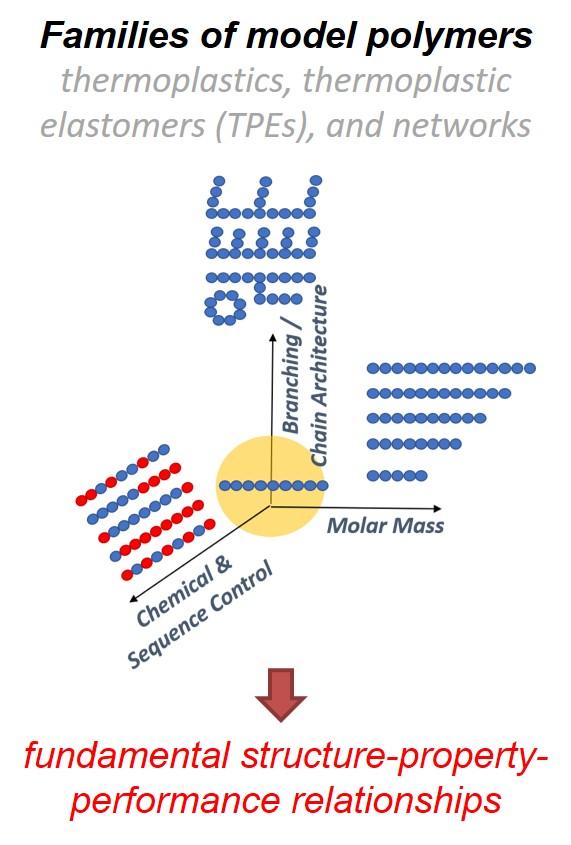
The project is currently looking at these structure-property relationships in a number of areas and applications in bulk materials. Tailored polyolefin copolymers are currently being studied for compatibilization of post-consumer resins, especially for challenging materials, such as multilayer packaging, where polymer immiscibility limit recycling potential. Focus areas include 1) expansion of LLDPE model materials to block, statistical and gradient copolymers and 2) deuterium labeled polyethylene segments to understand crystallization near features within the chain, such as defects or chain ends.
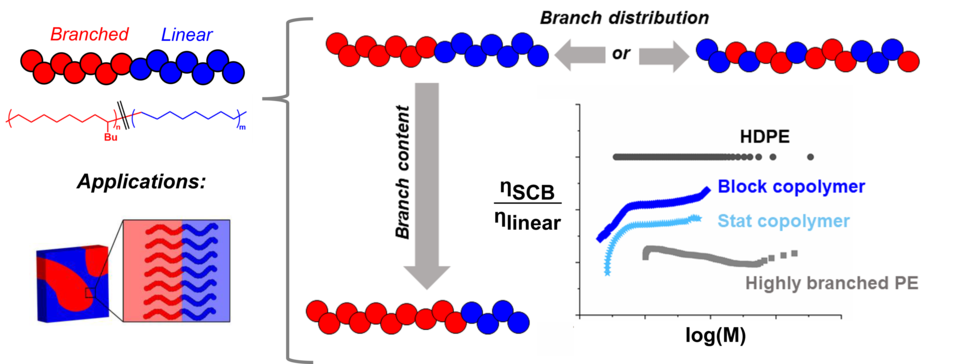
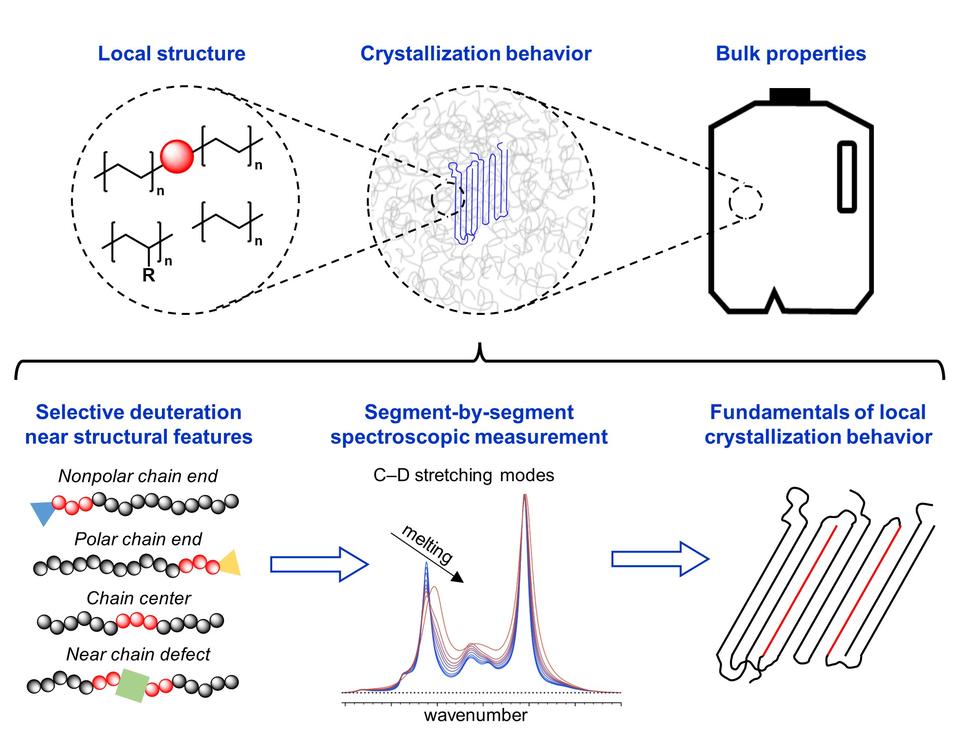
The integration of molecular dynamics simulations of model polymers with experimental data show that trends in intrinsic viscosity of short-chain branched polyethylene and polyethylene copolymers agree well. Ongoing collaborations with the Polymer Analytics Project continue to provide valuable validation of experimental structure-property data with theory and help guide future synthetic experiments to test new simulation models and methodologies.
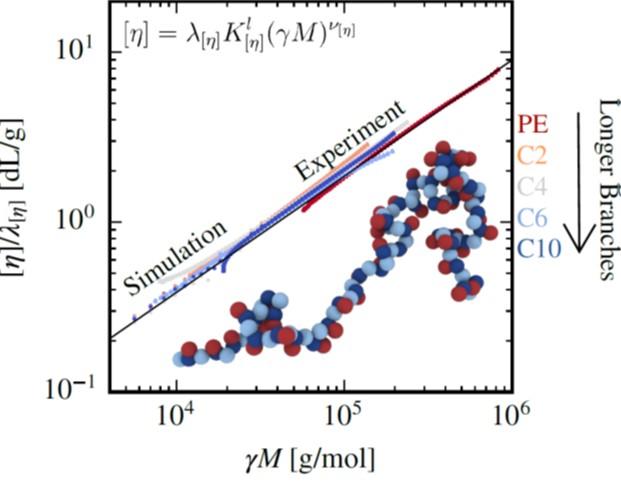
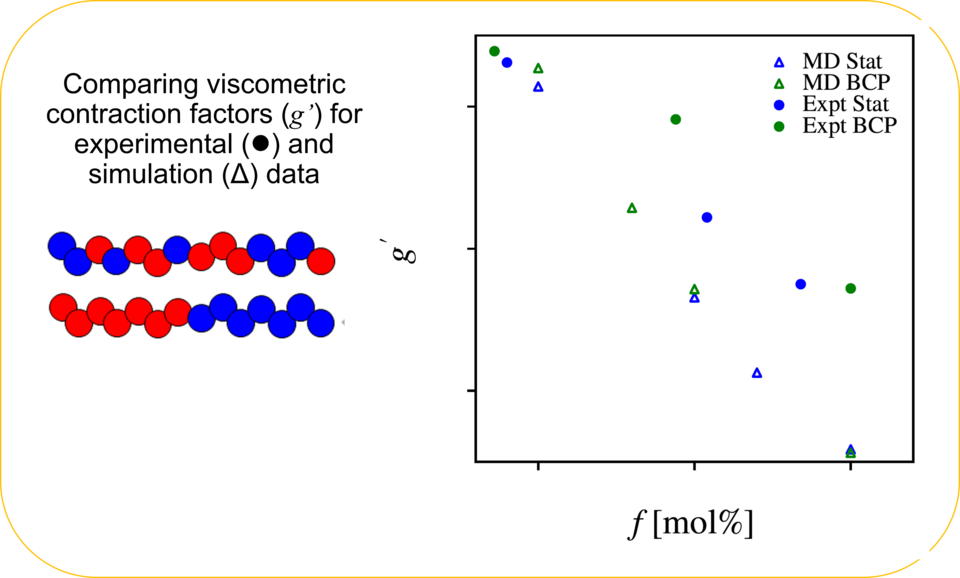
Polymer Degradation Metrology
This project also has research collaborations regarding characterization of catalytically and environmentally degraded materials to determine the changes in chemistry, molar mass distribution, and chain architecture as plastics decompose, which are necessary to generate accurate models of degradation kinetics and material half-life. The research area aims to develop methodologies to quantitatively identify recovered materials and characterize molar mass, branching content, and chemical composition of degraded of plastics from ocean debris and laboratory-controlled degradation experiments. This has applications in studying failure of ballistic fibers, the development of catalysts for chemical recycling, and environmental aging metrics.
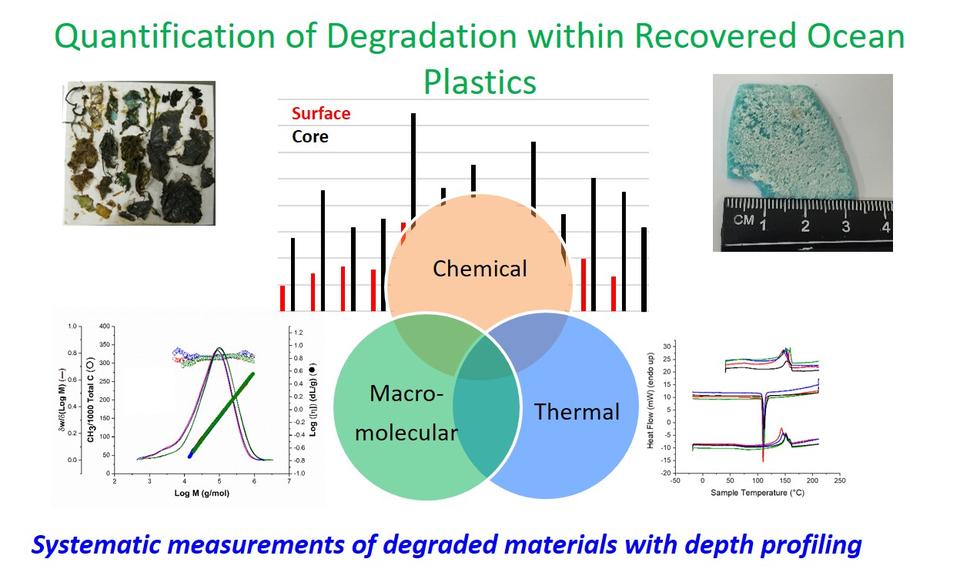
Metrology for the circular economy: Improving Classification of Commercial Polyolefins via Correlation of Near-Infrared Spectra to Bulk Properties
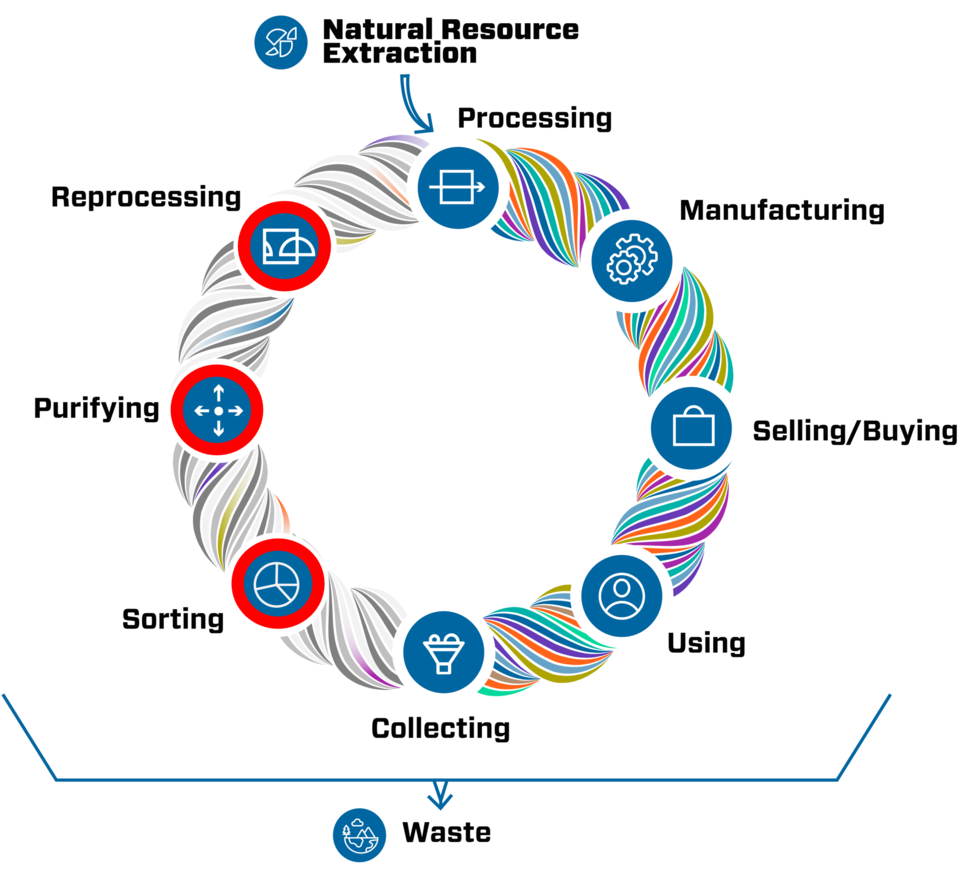
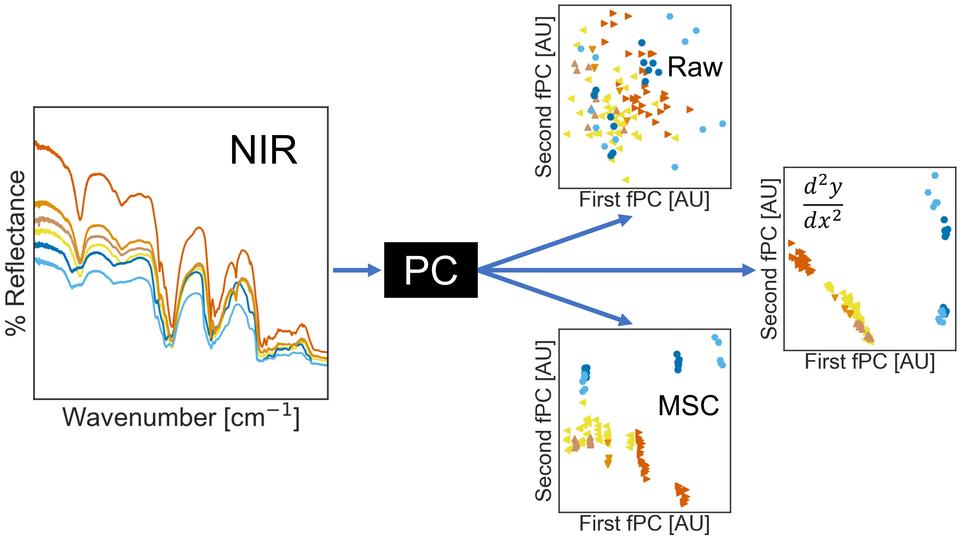
This is a new focus area. Infrared (IR) spectroscopy is the rapid, workhorse technique used by recycling facilities for materials classification yet as currently used it does not provide complete identification of many recycled materials. Furthermore, conventional IR analysis is particularly insensitive to variations in molecular architecture that can have outsize impact on processing parameter landscapes. IR measurements have the potential to give more information about post-consumer resin (PCR) beyond rapid sorting of conventional resin classes, provided quantitative data and tools can establish standards for such practices from sound fundamental measurements. While more robust characterization techniques to measure chain composition, topology, and conformation (e.g., multidetector chromatography, small-angle scattering, among others) can be used off-line, they are too slow to provide utility in a modern sorting facility. A measurement modality that bridges the speed and cost of IR with the classification ability of other analytical techniques is needed.
To address this challenge, we are working to develop ML tools that extract new types of information from existing online infrared (IR) measurements. Specifically, we will look at machine learning (including functional principle component analysis to improve chemometric analysis from IR measurements and directly correlate chemical signatures from IR to structural information from more robust analytical techniques (e.g. chromatography, scattering). A library of chemical composition data will be generated and the measurement signals will be correlated using multitask machine learning, which has previously been shown to improve predictive capabilities. The resulting machine learning model will allow IR classification of PCR materials with unprecedented fidelity at production speed and will provide FAIR datasets for future development of improved commercial algorithms for advanced sorting and processing equipment.
Major Accomplishments
Publications:
Ellis, L. D.; Orski, S. V.; Kenlaw, G. A.; Norman, A. G.; Beers, K. L.; Román-Leshkov, Y.; Beckham, G. T. Tandem Heterogeneous Catalysis for Polyethylene Depolymerization via an Olefin-Intermediate Process. ACS Sustainable Chem. Eng. 2021, 9, 2, 623-628.
Zhang, W.; Vargas-Lara, F.; Orski, S. V.; Beers, K. L.; Douglas, J. F. Modeling Short-chain Branched Polyethylenes in Dilute Solution under Variable Solvent Quality Conditions: Basic Configurational Properties. Polymer, 2021, 217, 123429.
Pickett, P. D.; Orski, S. V.; Prabhu, V. M. Development of aqueous size exclusion chromatography conditions to characterize polyzwitterion-block-N-isopropyl acrylamide copolymers. J. Chrom. A, 2020, 1628, 461424.
Cole, D.P.; Gardea, F.; Henry, T. C.; Seppala, J. E.; Garboczi, E. J.; Migler, K. D.; Shumeyko, C. M.; Westrich, J. R.; Orski, S. V.; Gair, J. L.; AMB2018-03: Benchmark Physical Property Measurements for Material Extrusion Additive Manufacturing of Polycarbonate. Integrating Materials and Manufacturing Innovation, 2020, 9, 4, 358-375.
Orski, S. V.; Kassekert, L. A.; Farrell, W. S.; Kenlaw, G. A.; Hillmyer, M. A.; Beers, K. L. Design and Characterization of Model Linear Low-Density Polyethylenes (LLDPEs) by Multi-Detector Size Exclusion Chromatography. Macromolecules 2020, 53, 7, 2344-2353.
Hsueh, H-C.; Kim, J. H. Orski, S.; Fairbrother, A.; Jacobs, D.; Perry, L.; Hunston, D.; White, C.; Sung, L. Micro and Macroscopic Mechanical Behaviors of High-Density Polyethylene Under UV Irradiation and Temperature. Polym. Degrad. Stab. 2020, 174, 109098.
Duncan, T. T.; Chan, E. P, Beers, K .L. Maximizing Contact of Supersoft Bottlebrush Networks with Rough Surfaces To Promote Particulate Removal. ACS Appl. Mater. Interfaces 2019, 11, 48, 45310–45318.
J. Sarapas, T. Martin, A. Chremos, J. Douglas, K. Beers. Bottlebrush polymers in the melt and polyelectrolytes in solution share common structural features. Proc. Nat. Acad. Sci. 2020, 117 (10) 5168-5175
Farrell, W. S.; Orski, S. V.; Kotula, A. P.; Baugh III, D. W.; Snyder, C. R.; Beers, K. L. Precision, Tunable Deuterated Polyethylene via Polyhomologation. Macromolecules. 2019, 52, 15, 5741-5749.
Jung, M. R.; Balazs, G. H.; Work, T. M.; Jones, T. T.; Orski, S. V.; Rodriguez C., V.; Beers, K. L.; Brignac, K. C.; Hyrenbach, K. D.; Jensen, B. A.; et al. Polymer Identification of Plastic Debris Ingested by Pelagic-Phase Sea Turtles in the Central Pacific. Environ. Sci. Technol. 2018, 52 (20), 11535-11544.
Jung, M. R.; Horgen, F. D.; Orski, S. V.; Rodriguez C., V.; Beers, K. L.; Balazs, G. H.; Jones, T. T.; Work, T. M.; Brignac, K. C.; Royer, S.-J.; et al. Validation of ATR FT-IR to Identify Polymers of Plastic Marine Debris, Including Those Ingested by Marine Organisms. Mar. Pollut. Bull. 2018, 127, 704–716.
This project is also responsible for testing and answering questions on NIST’s polyethylene and polystyrene molar mass reference materials and SRMs.

